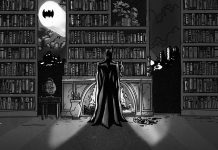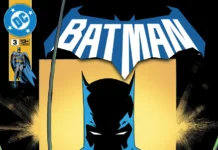PREVIOUS: A Joker’s Dozen, Part 11
One of the touchstones of The Joker’s interpretation in comics is the first dozen stories featuring the Joker that follow his introduction as a cold blooded killer and his transformation into a clever prankster that would bedevil Batman over the years without falling prey to the morality police. This is the last article of the series.
 The Comic/Story: “The Joker Walks the Last Mile!” from DETECTIVE COMICS #64, June of 1942
The Comic/Story: “The Joker Walks the Last Mile!” from DETECTIVE COMICS #64, June of 1942
The Return: No explanation given.
The Plot: The Joker confesses to his crimes and is executed. He then rises from a formula of his own creation to enjoy his accumulated wealth. He can’t resist the temptation to pull off crimes under Batman’s nose though.
Body Count: None, unless you count The Joker himself.
Joker’s Running Body Count: 25 — plus potential car crash, train wreck, and bus crash victims
Other Mayhem: The Joker’s henchmen blackjack a guard. Joker tussles briefly with Batman and Robin when discovered free. Joker’s henchmen stage a robbery at an ice show and tussle with Batman and Robin. Joker has a running fight while escaping from Batman and Robin and knocks out a car driver in the process, stealing the car for his escape.
The Outthink: Batman tricks The Joker into revealing a “stolen” watch implicating The Joker in the robbery.
The Comeuppance: The Joker takes a plunge into the ocean after being hit across the face with a dangling line from the Batplane.

The story opens with a near splash page of The Joker being given the third degree by a group of cops while the narrative box has The Joker’s obituary and promises that the obituary is only the beginning of the story. The story commences proper with The Joker in his hideout with a pair of henchmen. The henchmen are having a fine time, enjoying a beer and listening to a ball game, Dimaggio is batting, and The Joker will have none of it. The Joker wants to be out and enjoying his perfectly hedonist lifestyle as Steve Englehart would put it. Being cooped up is like a living death to him, an ironic sentiment for someone who started out with a hideout in a mausoleum just a couple of years prior. .Which shows how much The Joker had already changed within a dozen stories. The living death statement does give The Joker an idea though, which he outlines, off panel, to his henchmen. The fact that The Joker has a plan is a curious decision from Bill Finger as it takes a certain sense of mystery away from the next part of the story. The Joker concludes his plan, in a nicely drawn panel featuring a death’s head in cigarette smoke, that “The Joker must die so that he may live again!” And he then promptly shows up at a police station to surrender and confess.
On a side note, it’s worth noting that The Joker is distinctly shown as being rather unsophisticated. He smokes cigarettes, but they’re of the regular blunt variety, unlike The Penguin and Catwoman of the period who are always shown smoking from long tipped filters. Can anyone imagine The Penguin and Catwoman letting their henchmen have beer and listen to baseball games either? It’s subtle, but it does firmly establish that The Joker is not a “high class” crook.
The surrender of The Joker obviously causes a figurative circus. It’s all over the newspapers. Including Chinese language papers that Asian caricatures read on the subway. People parade through the jail to catch sight of The Joker, including Bruce Wayne and Dick Grayson who stop by to confirm it’s the real deal. And, The Joker confesses to everything, which comically amount to at least three thick volumes. And, on a continuity note, The Joker even mentions “The Case of the Lucky Lawbreakers” by name. There’s a quick trial, a sentence of death, a trip to the chamber with a completely unafraid Joker, a moody panel, worthy of EC of a decade later, of the electrocution, and a doctor’s pronouncement that The Joker is dead in quick succession.
We then turn to the moodiest sequence in the story. The Joker is dead, but his henchmen break into the morgue, subdue the guard with a blackjack, and make away with The Joker’s body. All of this happening in the dead of night under a full moon. They quickly force a serum down The Joker’s throat After a panel, the drug works and The Joker is free. Early on, The Joker stories had contained some undead imagery and this sequence is complete with it. It’s too bad they didn’t have the henchmen dig The Joker out of a grave to really complete the sequence, but we have The Joker’s dead body, slightly reminiscent of a scene in THE DARK KNIGHT, and The Joker literally is brought back from the dead. We’ve pretty much lost that imagery even in subsequent return to serious stories except in brief instances, but I think it’s really fitting for the last look at the deadly serious Joker for over 20 years.
Immediately after his return to life, The Joker decides to flaunt himself. He goes window shopping in his Sunday best, with a regular tie and gloves, his outfit looks fairly similar to Heath Ledger’s. It’s not too long before The Joker attracts attention and Batman and Robin are there to round him up after a brief, somewhat comical, scuffle at which point The Joker reveals his scheme. Since he’s been convicted of every crime he’s been accused of and paid the price, he’s immune from prosecution due to double jeopardy.

Of course, we’re about halfway through the story and no criminal scheme has emerged to give Batman and Robin something to do. It’s time for the second part of the tale to kick in. The Joker has decided that he’s going to plan crimes in plain sight. Batman and Robin have The Joker’s hotel room staked out, Batman in disguise during the day as a blind pencil salesman, Robin in disguise at night as a shoeshine boy. Neither of them notice though that The Joker is using the blinking light of the hotel sign to send coded messages to his gang.
As is often the case in these early stories, Bruce and Dick decide to take a break from a case that’s getting them nowhere by going out for entertainment. This time it happens to be an ice skating show. And who turns up in their very box, but The Joker? It doesn’t take long, a set of pipes under the ice burst open and the Joker’s gang shows up to rob the audience in the confusion, including The Joker himself. Batman and Robin show up, and shades of the 1997 film BATMAN AND ROBIN, put on ice skates and take the fight to the thieves. A convenient blackout, certainly the work of the offpanel Joker, allows the thieves to escape and nothing to do but to report the incident to the police. The Joker, accurately, reports himself being robbed of a gold hunting case watch and $500. He then gives a jaunty goodbye to Batman and Robin, just to see how bewildered they are by the turn of events.
More determined than ever, Batman is convinced that the watch theft was phony and that they’ll go search The Joker’s room that night for proof. Returning to The Joker’s hotel, Robin notices that the sign is blinking and puts together that The Joker’s been using it to send code. They both rush up to The Joker’s room to find The Joker and the police waiting to arrest the Dynamic Duo on charges of breaking and entering. Batman asks for precisely one minute to explain himself, and The Joker falls for the ruse and pulls out the stolen watch to track the time, immediately realizing how he’s implicated himself. Before he can be arrested, The Joker makes a break out the fire escape and steals a jeep from a passing soldier, with Batman and Robin in hot pursuit in the Batmobile.
Throughout the story, there’s been references to the war going on. “Buy War Bonds” is prominently featured in a subway car and bombers are shown in the background silhouetted against a full moon elsewhere. Bill Finger explicitly praises the Jeep in the story with the idea that the Jeep’s ability to “leave the road go anywhere” makes it more than a match for The Batmobile. Luckily, they pass close enough by Wayne Manor for Batman to go retrieve The Batplane and act as airborne spotter while Robin pursues in the Batmobile. Eventually, The Joker, under relentless pursuit, cracks up the Jeep on a boulder and starts scrambling on some cables stretching between cliffs for a route of escape. Robin pursues, using a rope from the Batplane to lift him up to the overhead cables quickly, but before a fight can fully break out The Joker is hit in the face by the dangling rope and falls into the sea seemingly to his death again. And we’re soon full circle with The Joker back in hiding while his henchmen enjoy a beer.
At the end of the day, certainly not the most memorable of the early Joker stories, the crime plot is very weak as anything but to fill out a tale short on action, but a story that effectively freed The Joker from his past, and into a successful second phase of his career as the ultimate prankster villain. He’d still be fairly dangerous, at least until the 1950s and the CCA, but he’d no longer be the mass murdering lunatic he’d been before and instead focus on clever and grand schemes where outthinking Batman would be the chief prize, not how big a body count he could create. And, although many of the stories are childish, they permitted a freshness of plot from story to story that allowed The Joker to flourish. Recall, how many of the post-THE DARK KNIGHT RETURNS/THE KILLING JOKE/A DEATH IN THE FAMILY stories devolved into “Batman, why haven’t you killed The Joker?” stories and you can appreciate how liberating it is not to have a villain so tied to his past crimes. The Joker without that baggage was able to evolve and change with the times just like Batman and change back into what he once was when the 1970s arrived. – Robert Reineke
He’s earned a BS and MS degrees from the University of Wisconsin
and has been reading Batman comics since the 1970s.
He’s of the firm belief that there are plenty of Batman comics
written before Frank Miller that are worthy of discussion.













